Contextual Menus of Input Boxes |
  
|
When working with the Parameters window or various dialog windows containing input boxes, you can call a contextual menu by placing the cursor in the input box and pressing ![]() :
:
Depending on the type of data to be inputted into a box, a contextual menu may contain various commands of the following set:
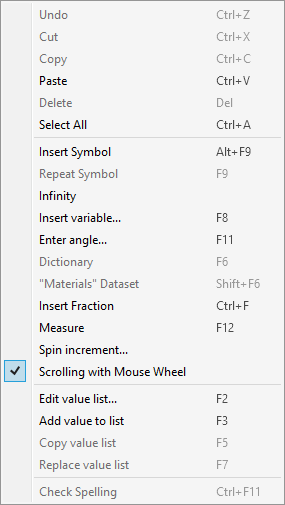
Undo <Ctrl>+<Z>.
Undo the last change.
Cut <Ctrl>+<X>.
Cut the selected text to the clipboard.
Copy <Ctrl>+<C>.
Copy the selected text to the clipboard.
Paste <Ctrl>+<V>.
Paste the selected text from the clipboard.
Delete <Del>.
Delete the selected text.
Select All <Ctrl>+<A>.
Select all text in the current box.
Insert Symbol <Alt>+<F9>.
Insert a symbol from the symbols insertion dialog. Working with the dialog is similar to described for inserting symbols into text.
Not the symbol itself is shown in the input box, but its code from the table (for example, %%066 is the diameter symbol). By default, if text defined by some input box is shown in italic font on the drawing, then the inserted symbol is also italic. However, if you enable the Ignore font angle checkbox in the symbols insertion dialog, then the "minus" is added to the symbol's code after %%, and the symbol is shown in regular font, while the rest of the text remains italic. Minus may also be added to symbol's code manually by typing it from the keyboard.

If you know the code of the symbol, you can type it into the input box manually using the keyboard without calling the Insert Symbol command.
Additionally, the T-FLEX CAD allows defining most common symbols as well as text formatting modes using the special codes similar to the ones used in other systems:
%%c - diameter;
%%d - degree;
%%p - plus-minus;
%%u - enable/disable underscore;
%%o - enable/disable overscore.
In order to mark a specific part of text with undercore or overscore, input the corresponding code twice - before and after the substring that needs to be marked. If a code is inputted once, the markup is applied to all symbols after it.
~ or ` symbol at the first position in a text string enables square or rounded frame correspondingly. Same symbols at any other position are treated as part of the string and do not affect the frame.
|
|
|
No frame |
Square frame |
Rounded frame |
Codes and symbols listed above do not affect multiline text, paragraph text and text in table cells.
Repeat Symbol <F9>.
Reinserting a symbol.
Infinity.
Inserting the ∞ symbol.
Insert variable… <F8>.
Inserting a variable from the list of already created ones. The variable name in curly braces is inserted into the dialog box. The value of the variable is displayed on the drawing. You can change the values of variables in the variable editor or, in some cases, directly in the drawing.
Enter angle… <F11>.
This command converts the angle value to a decimal number. The command calls a dialog box, in the corresponding fields of which you can enter the angle value in degrees, minutes, seconds. This value will be converted to decimal.
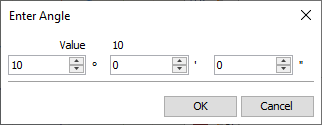
Dictionary. <F6>.
Insert text from a T-FLEX CAD dictionary. Working with dictionaries is described in the Inserting Text from Dictionary section.
Insert Fraction <Ctrl>+<F>.
Inserting a fraction into the input box. Can be used, for example, when specifying the content of text boxes for dimensions, labels, texts, etc.
When the command is called, an auxiliary dialog window appears on the screen for specifying the parameters of the fraction.
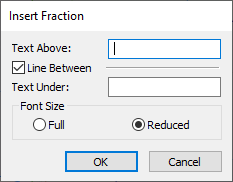
Measure <F12>.
This command allows you to read geometric data from existing drawing elements and use it when creating new elements. In doing so, you can create parametric dependencies between elements. For more information, see the Measure section.
Spin increment… <F4>.
You can set the increment of the parameter value when scrolling. In the scrolling step settings window, you can set one of three positions: Default, Value, By Value List.
•Value.
Set the numerical value of the value increment.
•By Value List.
Setting this option will allow scrolling through the list of values, if, of course, a list of values has been created for the current dialog field.
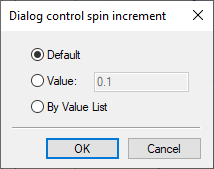
Edit value list… <F2>.
You can create lists of values for input boxes. For some boxes, such lists are created by default (for example, the Value field in the GD&T Formlimits dialog box). The command calls the window for editing the list of values. The list can be split into columns, as well as separate groups of data in a column with horizontal separators.
Default lists of values are stored in the DlgData_METRIC.ini file for the metric system and DlgData_INCH.ini for the inch system. These files are located in the Program folder within the T-FLEX CAD installation folder.
Custom lists of values are stored in the current environment. Thus you can transfer them between workplaces by exporting/importing environments.
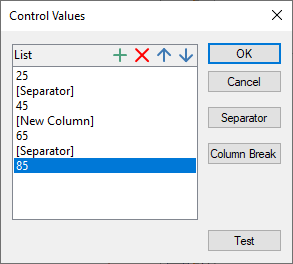
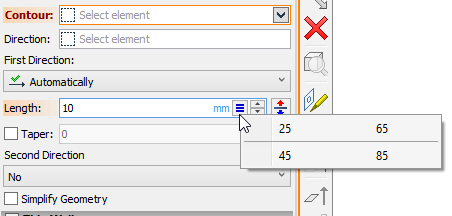
Add value to list <F3>.
This command adds the current value from the input box to the list. If there is no list, then it is created.
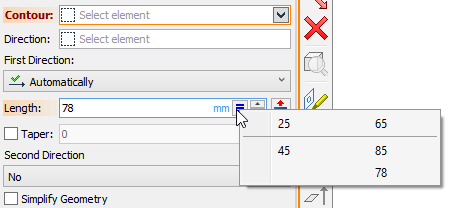
Copy value list <F5>.
The command copies the list of values of the given input box to the clipboard.
Replace value list <F6>.
The command replaces the list of values available for the given input box with the list of values from the buffer. The list must be copied to the clipboard in advance using the Copy value to list command.
Check Spelling <Ctrl>+<F11>.
Check the spelling of the contents of the input box for which the context menu was invoked.